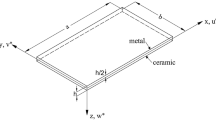Abstract
A combined theoretical and experimental study of the problem of crack growth in a plate subjected to unsymmetrical three-point bending was undertaken. The opening-modeK I and sliding-modeK II stress-intensity factors describing the local stress field around the crack tip were determined by a finite-element computer program. The crack growth was analyzed by the maximum circumferential stress and the minimum strain-energy density criteria. The critical loads for crack growth and the crack trajectories were determined both by theory and experiment. The experimental results corroborated the theoretical predictions.
Similar content being viewed by others
References
“Developments in Fracture Mechanics Test Methods Standardization,”ed. W.F. Brown, Jr. andJ.G. Kaufman, ASTM STP 632, Amer. Soc. Test. and Mat., Philadelphia, 221–240 (1977).
Srawley, J.E. andBrown, W.F. Jr., “Fracture Toughness Testing Methods,”Fracture Toughness Testing and its Applications, ASTM STP 381, Amer. Soc. Test. and Mat., Philadelphia, 133–198 (1965).
Srawley, J.E. andGross, B., “Stress Intensity Factors for Bend and Compact Specimens,”Eng. Fract. Mech.,4,587–589 (1972).
Srawley, J.E., “Wide Range Stress Intensity Factor Expression for ASTM E 399 Standard Fracture Toughness Specimens,”Int. J. Fract.,12,475–476 (1976).
Jen, W.K., Lin, H.C. and Hua, K., “Calculation of Stress Intensity Factors for Combined Mode Bend Specimens,” Advances in Research on the Strength and Fracture of Materials, Proc. 4th Int. Conf. on Fract., ed. D.M.R. Taplin, Pergamon Press,4,123–133 (1978).
Ingraffea, A.D. and Gerstle, W.H., “Non-linear Fracture Models for Discrete Crack Propagation,” Application of Fracture Mechanics to Cementitious Composites, ed. S.P. Shah, Martinus Nijhoff Publishers, 247–285 (1985).
Erdogan, F. andSih, G.C., “On the Crack Extension in Plates Under Plane Loading and Transverse Shear,”J. Basic Eng.,85D,519–527 (1963).
Sih, G.C., “Strain-Energy-Density Factor Applied to Mixed Mode Crack Problems,”Int. J. Fract.,10,305–321 (1974).
Gdoutos, E.E., “Problems of Mixed-Mode Crack Propagation,” Martinus Nijhoff Publishers (1984).
Cotterell, B. andRice, J.R., “Slightly Curved or Kinked Cracks,”Int. J. Fract.,16,155–169 (1980).
Author information
Authors and Affiliations
Rights and permissions
About this article
Cite this article
Gdoutos, E.E., Zacharopoulos, D.A. Mixed-mode crack growth in plates under three-point bending. Experimental Mechanics 27, 366–369 (1987). https://doi.org/10.1007/BF02330308
Received:
Revised:
Issue Date:
DOI: https://doi.org/10.1007/BF02330308




